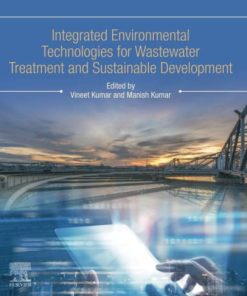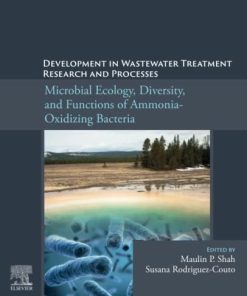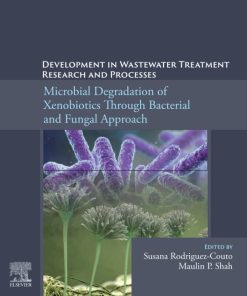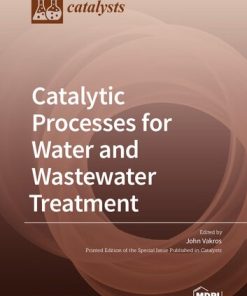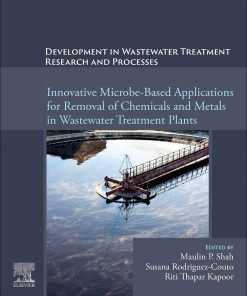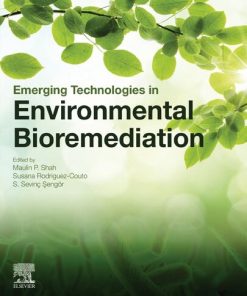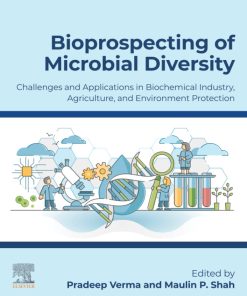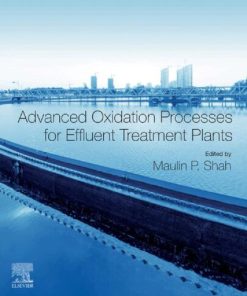Development in Wastewater Treatment Research and Processes 1st edition by Maulin Shah 0323900119 9780323900119
$50.00 Original price was: $50.00.$25.00Current price is: $25.00.
Development in Wastewater Treatment Research and Processes 1st edition by Maulin P. Shah – Ebook PDF Instant Download/DeliveryISBN: 0323900119, 9780323900119
Full download Development in Wastewater Treatment Research and Processes 1st edition after payment.
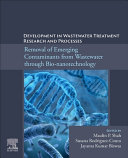
Product details:
ISBN-10 : 0323900119
ISBN-13 : 9780323900119
Author : Maulin P. Shah
Removal of Emerging Contaminants from Wastewater through Bio-nanotechnology showcases profiles of the nonregulated contaminants termed as “emerging contaminants, which comprise industrial and household persistent toxic chemicals, pharmaceuticals and personal care products (PPCPs), pesticides, surfactants and surfactant residues, plasticizers and industrial additives, manufactured nanomaterials and nanoparticles, microplastics, etc. that are used extensively in everyday life. The occurrence of “emerging contaminants in wastewater, and their behavior during wastewater treatment and production of drinking water are key issues in the reuse and recycling of water resources.
This book focuses on the exploitation of Nano-biotechnology inclusive of the state-of-the-art remediate strategies to degrade/detoxify/stabilize toxic and hazardous contaminants and restore contaminated sites, which is not as comprehensively discussed in the existing titles on similar topics available in the global market. In addition, it discusses the potential environmental and health hazards and ecotoxicity associated with the widespread distribution of emerging contaminants in the water bodies. It also considers the life cycle assessment (LCA) of emerging (micro)-pollutants with suitable case studies from various industrial sources.
Development in Wastewater Treatment Research and Processes 1st Table of contents:
Chapter 1 Nanoadsorbents for scavenging emerging contaminants from wastewater
Abstract
1.1 Introduction
1.2 Emerging contaminants
1.3 Occurrence of emerging contaminants in aquatic systems
1.4 Exposure pathways of emerging contaminants in the environment
1.5 Treatment technologies for removal of ECs
1.6 Conventional treatment methods
1.7 Emerging methods
1.7.1 Biological treatment method
1.7.2 Advanced oxidation process
1.8 Nanoadsorbents
1.9 Classification of nanoadsorbents
1.10 Methods for preparation of nanoadsorbents
1.11 Properties of nanoadsorbents
1.12 Mechanisms of nanoadsorption
1.13 The π-π interaction
1.14 Electrostatic interaction
1.15 Hydrophobic interaction
1.16 Hydrogen bonding
1.17 Factors affecting adsorption process
1.17.1 pH
1.17.2 Ionic strength
1.17.3 Dissolved organic matter
1.18 Conclusions
References
Chapter 2 Treatment aspect of an emerging pollutant from Pharmaceutical industries using advanced oxidation process: past, current, and future trends
Abstract
2.1 Introduction
2.2 Treatment technologies
2.3 Advanced oxidation process
2.4 Future prospects
References
Chapter 3 Membrane bioreactor (MBR) as an advanced wastewater treatment technology for removal of synthetic microplastics
Abstract
3.1 Introduction
3.2 Microplastic generation and pollution
3.3 Effect of Synthetic microplastic pollution
3.4 Technical implementation of membrane bioreactor (MBR) for elimination micro plastic pollutants
References
Chapter 4 Strategies to cope with the emerging waste water contaminants through adsorption regimes
Abstract
4.1 Introduction
4.2 Uptake of pollutants from water via adsorption
4.3 Adsorbents and there use in purification of waters
4.4 Various emerging pollutants and their effects
4.5 Adsorption strategies for removal of emerging pollutants from waste waters
4.6 Adsorption of pollutants using hydrothermal carbonization: an environment safe procedure using carbon adsorbents
4.7 Use of hydrothermal carbonization (HTC) in adsorption
4.8 Metals and metal ions adsorption by HTCs
4.9 Adsorption of metal(s) from mixture of metals
4.10 Adsorption of heavy metals using HTCs
4.11 Use of cost-effective adsorbent for adsorption of heavy metals
4.12 Uptake of metals using low-cost adsorbent materials
4.13 Use of agricultural residues as adsorbents
4.14 Uses of industrial wastes as adsorbents
4.15 Adsorption/biosorption of antibiotics from waste water
4.16 Elimination of heavy metals via adsorption/biosorption
4.17 Heavy metals uptake using activated sludge and sludge-derived materials
4.18 Uptake of endocrine disrupting chemicals (EDC)
4.19 Future prospects
4.20 Conclusion
References
Chapter 5 Performances of membrane bioreactor technology for treating domestic wastewater operated at different sludge retention time
Abstract
5.1 Introduction
5.1.1 Fundamentals of membrane bioreactors
5.1.2 Development of MBR studies
5.1.3 Membrane fouling in MBR systems
5.1.4 Performances of MBRs at high biomass retention
5.1.5 Task and purpose of the study
5.2 Materials and methods
5.2.1 Experimental setup
5.2.2 Sludge retention time
5.2.3 Analysis methods
5.3 Results and discussion
5.3.1 Effect of SRTs on sludge concentration in the system
5.3.2 Effects of SRT on sludge bioactivity
5.3.3 Effect of SRT on SVI and viscosity
5.3.4 Effects of SRT on COD removal in the system
5.4 Influence of SRT on sludge particle size distribution
5.5 Conclusions
Acknowledgements
Abbreviations
References
Chapter 6 Advances in nanotechnologies of waste water treatment: strategies and emerging opportunities
Abstract
6.1 Introduction
6.2 Metallic nanoparticles
6.3 Nanoadsorbents
6.4 Nanobiosorbents
6.5 Nanomembranes
6.6 Nanocatalysts
6.7 Conclusions
Acknowledgements
References
Chapter 7 Water and Wastewater Treatment through Ozone-based technologies
Abstract
7.1 Introduction
7.2 Global water scenario
7.3 Strategies for solving the water shortage issues
7.4 Why ozone-based technologies used for water and wastewater treatment?
7.5 Worldwide status, history, and background of O3 based technology for drinking water and wastewater treatment
7.6 Use of ozone-based technology for disinfection
7.7 Treatment of municipal and industrial wastewater through Ozone-based technology
7.8 Removal of physical pollutants (odor and taste) through Ozone-based technologies
7.9 Removal of various chemical pollutants (COD, BOD and coloring agents) from wastewater through Ozone-based technologies
7.10 Factors affecting the Ozonation process
7.11 Conclusion and Future prospects
References
Chapter 8 Constructed wetland: a promising technology for the treatment of hazardous textile dyes and effluent
Abstract
8.1 Introduction
8.2 Classification of dyes
8.3 Impact of dye toxicity on environment
8.4 Impact of dye toxicity on living beings
8.5 Dye remediation strategies
8.6 Constructed wetlands: a step towards technology transfer
8.7 Classification of constructed wetlands
8.8 Recent developments in textile wastewater treatments using constructed wetlands
8.9 Conclusion and future prospective
References
Chapter 9 Biogenic nanomaterials: Synthesis, characteristics, and recent trends in combating hazardous pollutants (An arising scientific horizon)
Abstract
9.1 Introduction
9.2 History of nanotechnology and conventional synthetic routes of nanomaterials
9.3 Nanobiotechnology: An arising scientific horizon
9.4 Advantages, limitations, drawbacks, and future perspectives of nanobiotechnology
9.5 Conclusions
References
Chapter 10 Removal of emerging contaminants from pharmaceutical wastewater through application of bionanotechnology
Abstract
10.1 Introduction
10.2 Overview of contaminants in pharmaceutical wastewater
10.3 Applications of nanomaterials for the removal of pharmaceutical contaminants
10.4 Concluding remarks
References
Chapter 11 Recent advances in pesticides removal using agroindustry based biochar
Abstract
11.1 Introduction
11.2 What is biochar?
11.3 Characteristics of biochar
11.4 Modified biochar
11.5 Hazards of pesticides to environment and health
11.6 Recent development in pesticides sorption on biochar
11.7 Conclusion and future perspective
References
Chapter 12 Bioremediation – the natural solution
Abstract
12.1 Introduction
12.2 Characteristics of municipal wastewater
12.3 Wastewater treatment
12.4 Post-treatment options
12.5 Comparison of various biological treatment processes
12.6 Sand filter for the post treatment
12.7 Conclusion
References
Chapter 13 Detection and removal of pathogenic bacteria from wastewater using various nanoparticles
Abstract
13.1 Presence of different contaminants in wastewater
13.2 Pathogenic bacterial component in wastewater
13.3 Detection of pathogenic bacteria using different nanoparticles
13.4 Conclusion
References
Chapter 14 Application of TiO2 photocatalysts hybridized with carbonaceous for degradation of pharmaceuticals
Abstract
14.1 Introduction
14.2 Pharmaceuticals
14.3 Advanced oxidative processes (AOP)
14.4 Carbonaceous TiO2 doping
14.5 Graphene–TiO2
14.6 Carbon Nanotubes–TiO2
14.7 Activated carbono-TiO2
14.8 Concluding remarks and future challenges
Acknowledgments
References
Chapter 15 Moving bed biofilm reactor- (MBBR-) based advanced wastewater treatment technology for the removal of emerging contaminants
Abstract
15.1 Introduction
15.2 Overview of the moving bed biofilm reactor (MBBR)
15.3 Operating benchmarks of the MBBR
15.4 Effect of operating parameters
15.5 Mathematical models used in kinetics evaluation of the MBBRs
15.6 Recent applications of MBBRs in the wastewater treatment
15.7 Conclusions
Acknowledgment
References
Further readings
Chapter 16 An application of bionanotechnology in removal of emerging contaminants from pharmaceutical waste
Abstract
16.1 Introduction
16.2 Methods for treatment of pharmaceutical waste water
16.3 Different nanomaterials and treatment of pharmaceutical waste water
16.4 Conclusion
References
Chapter 17 Removal of emerging contaminants in water treatment by an application of nanofiltration and reverse osmosis
Abstract
17.1 Introduction
17.2 Factors affecting performance of nanofiltration
17.3 Nanofiltration with modifications and applications
17.4 Advantages and limitations of nanofiltration
17.5 Factors affecting reverse osmosis
17.6 Applications
17.7 Advantages and limitations of reverse osmosis
17.8 Conclusion
References
Chapter 18 Membrane bioreactor as an advanced wastewater treatment technology
Abstract
18.1 Introduction
18.2 Membrane classification
18.3 Types of membrane bioreactor arrangements
18.4 Role of membrane bioreactors
18.5 Classification of membrane fouling
18.6 Membrane fouling in membrane bioreactor
18.7 Factors affecting membrane fouling in membrane bioreactor
18.8 Membrane fouling control
18.9 Membrane bioreactor model description and assessment
18.10 Membrane fouling models
18.11 Advantages and drawbacks of membrane bioreactor technology
18.12 Summary and conclusion
Acknowledgment
Competing interests
Consent for publication
Ethics approval and consent to participate
Abbreviations
References
Chapter 19 Removal of pesticides from water and wastewater by solar-driven photocatalysis
Abstract
19.1 Introduction
19.2 Photocatalysts and photocatalysis
19.3 Pesticides and toxicities
19.4 Wastewater treatment
19.5 Concluding remarks
References
Chapter 20 Recent applications, reaction mechanism, and future perspective of hybrid ozonation process for water and wastewater treatment
Abstract
20.1 Introduction
20.2 Combined ozonation for enhanced treatment of water
20.3 Catalytic ozonation
20.4 Application of ozonation process for the degradation of toxic organic pollutants
20.5 Shortcomings of hybrid ozonation processes
20.6 Benefits of hybrid ozonation processes
20.7 Conclusions and future perspective
References
Chapter 21 Removal of emerging contaminants from pharmaceutical waste through application of bio nanotechnology
Abstract
21.1 Introduction
21.2 Challenges in current wastewater treatment technologies
21.3 Enzyme immobilized nanomaterials for removal of emerging contaminants
21.4 Biogenic nanoparticles for removal of emerging contaminants
21.5 Other technologies for removal of emerging contaminants
21.6 Nanozymes
21.7 Conclusions and future prospects
References
Chapter 22 Antimicrobial activities of different nanoparticles concerning to wastewater treatment
Abstract
22.1 Silver nanoparticles
22.2 Gold nanoparticles
22.3 Zinc oxide nanoparticle
22.4 CuO nanoparticles
22.5 Iron oxide nanoparticles
22.6 Magnesium oxide nanomaterials
22.7 Titanium dioxide nanoparticles
22.8 Al2O3 nanomaterials
22.9 Nanomaterials enabled with antimicrobial peptides
22.10 Conclusion
Abbreviations
References
Chapter 23 Application of nanomaterial in wastewater treatment: recent advances and future perspective
Abstract
23.1 Introduction
23.2 Nano adsorption
23.3 Nanofiltration
23.4 Nanocatalyst
23.5 Nano Biocides
23.6 Future Prospect
References
Chapter 24 Photocatalytic removal of emerging contaminants in water and wastewater treatments: a review
Abstract
24.1 Introduction
24.2 Photocatalysis mechanisms
24.3 Impact of operating and process parameters
24.4 Common photocatalysts
24.5 Strategies for improving photocatalysis
24.6 Wastewater treatment applications
24.7 Conclusions and future challenges
References
Chapter 25 Biologically synthesized nanoparticles for dye removal
Abstract
25.1 Introduction
25.2 Bacteriogenic nanoparticles
25.3 Mycogenic nanoparticles
25.4 Phycogenic nanoparticles
25.5 Phytogenic nanoparticles
25.6 Conclusions and future perspectives
Acknowledgements
References
Chapter 26 Removal of emerging contaminants in water treatment by nanofiltration and reverse osmosis
Abstract
26.1 Introduction
26.2 Emerging contaminants in water
26.3 Reverse osmosis and nanofiltration
26.4 Solute denial mechanism by the nanofiltration/reverse osmosis membrane
26.5 Modern findings
26.6 Applications of nanofiltration membranes (Zhao et al., 2005)
26.7 Advantages and disadvantages
26.8 Future perspectives of nanofiltration
26.9 Conclusion
References
Chapter 27 Hybrid bioreactor in combination with ozone-based technologies for industrial wastewater treatment
Abstract
27.1 Introduction
27.2 Characteristics of industrial wastewater
27.3 Selection of an optimal treatment strategy
27.4 Hybrid bioreactor combined with ozone-based technology
27.5 Benefits of hybrid processes in combination with ozonation
27.6 Limitations of hybrid processes with ozone-based technology
27.7 Conclusion
References
Chapter 28 Metal organic frameworks (MOFs) in aiding water purification from emerging and ionic contaminants
Abstract
28.1 Introduction
28.2 Different synthesis methods for preparation of metal organic frameworks
28.3 Applications of metal organic frameworks for water treatment
28.4 Limitations of using metal organic frameworks and alternative strategy
28.5 Conclusions
Abbreviations
References
Chapter 29 Removal of emerging contaminants from wastewater through bionanotechnology
Abstract
29.1 Introduction
29.2 Definition of emerging contaminants
29.3 Sources of emerging contaminants
29.4 Environmental/health issues and regulations related to emerging contaminants
29.5 Conventional treatment technologies
29.6 Bionanotechnology for the removal of emerging contaminants
29.7 Future outlook
29.8 Conclusion
People also search for Development in Wastewater Treatment Research and Processes 1st:
what are the 3 stages of wastewater treatment
wastewater treatment in developing countries
wastewater treatment developments
water treatment research jobs
wastewater treatment research and development
Tags: Development, Wastewater, Treatment Research, Processes, Maulin Shah
You may also like…
Technique - Water Treatment
Technique - Water Treatment
Technique - Water Treatment
Biology and other natural sciences - Microbiology
Engineering - Environmental
Biology and other natural sciences - Microbiology




